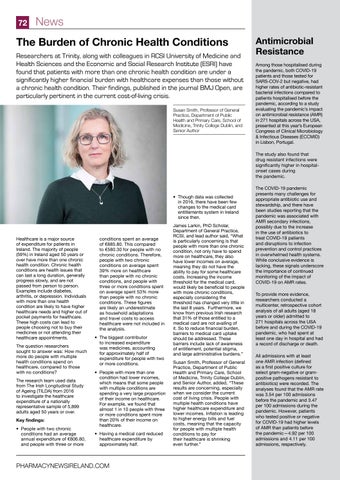72
News
The Burden of Chronic Health Conditions Researchers at Trinity, along with colleagues in RCSI University of Medicine and Health Sciences and the Economic and Social Research Institute (ESRI) have found that patients with more than one chronic health condition are under a significantly higher financial burden with healthcare expenses than those without a chronic health condition. Their findings, published in the journal BMJ Open, are particularly pertinent in the current cost-of-living crisis. Susan Smith, Professor of General Practice, Department of Public Health and Primary Care, School of Medicine, Trinity College Dublin, and Senior Author
Antimicrobial Resistance Among those hospitalised during the pandemic, both COVID-19 patients and those tested for SARS-COV-2 but negative, had higher rates of antibiotic-resistant bacterial infections compared to patients hospitalised before the pandemic, according to a study evaluating the pandemic’s impact on antimicrobial resistance (AMR) in 271 hospitals across the USA, presented at this year’s European Congress of Clinical Microbiology & Infectious Diseases (ECCMID) in Lisbon, Portugal. The study also found that drug resistant infections were significantly higher in hospitalonset cases during the pandemic.
• Though data was collected in 2016, there have been few changes to the medical card entitlements system in Ireland since then.
Healthcare is a major source of expenditure for patients in Ireland. The majority of people (59%) in Ireland aged 50 years or over have more than one chronic health condition. Chronic health conditions are health issues that can last a long duration, generally progress slowly, and are not passed from person to person. Examples include diabetes, arthritis, or depression. Individuals with more than one health condition are likely to have higher healthcare needs and higher out of pocket payments for healthcare. These high costs can lead to people choosing not to buy their medicines or not attending their healthcare appointments. The question researchers sought to answer was: How much more do people with multiple health conditions spend on healthcare, compared to those with no conditions? The research team used data from The Irish Longitudinal Study of Ageing (TILDA) from 2016 to investigate the healthcare expenditure of a nationally representative sample of 5,899 adults aged 50 years or over. Key findings: • People with two chronic conditions had an average annual expenditure of ¤806.80, and people with three or more
conditions spent an average of ¤885.80. This compared to ¤580.30 for people with no chronic conditions. Therefore, people with two chronic conditions on average spent 39% more on healthcare than people with no chronic conditions, and people with three or more conditions spent on average spent 53% more than people with no chronic conditions. These figures are likely an underestimate as household adaptations and travel costs to access healthcare were not included in the analysis. • The biggest contributor to increased expenditure was medicines, accounting for approximately half of expenditure for people with two or more conditions. • People with more than one condition had lower incomes, which means that some people with multiple conditions are spending a very large proportion of their income on healthcare. For example, we found that almost 1 in 10 people with three or more conditions spent more than 20% of their income on healthcare. • Having a medical card reduced healthcare expenditure by approximately half.
PHARMACYNEWSIRELAND.COM
James Larkin, PhD Scholar, Department of General Practice, RCSI, and lead author said, “What is particularly concerning is that people with more than one chronic condition, not only have to spend more on healthcare, they also have lower incomes on average, meaning they do not have the ability to pay for some healthcare costs. Increasing the income threshold for the medical card, would likely be beneficial to people with more chronic conditions, especially considering the threshold has changed very little in the last 8 years. Furthermore, we know from previous Irish research that 31% of those entitled to a medical card are not availing of it. So to reduce financial burden, barriers to medical card uptake should be addressed. These barriers include lack of awareness of entitlement, potential stigma, and large administrative burdens.” Susan Smith, Professor of General Practice, Department of Public Health and Primary Care, School of Medicine, Trinity College Dublin, and Senior Author, added, “These results are concerning, especially when we consider the current cost of living crisis. People with multiple health conditions have higher healthcare expenditure and lower incomes. Inflation is leading to higher energy bills and fuel costs, meaning that the capacity for people with multiple health conditions to pay for their healthcare is shrinking even further.”
The COVID-19 pandemic presents many challenges for appropriate antibiotic use and stewardship, and there have been studies reporting that the pandemic was associated with AMR secondary infections, possibly due to the increase in the use of antibiotics to treat COVID-19 patients and disruptions to infection prevention and control practices in overwhelmed health systems. While conclusive evidence is lacking, these signals underscore the importance of continued monitoring of the impact of COVID-19 on AMR rates. To provide more evidence, researchers conducted a multicenter, retrospective cohort analysis of all adults (aged 18 years or older) admitted to 271 hospitals across the USA before and during the COVID-19 pandemic, who had spent at least one day in hospital and had a record of discharge or death. All admissions with at least one AMR infection (defined as a first positive culture for select gram-negative or grampositive pathogens resistant to antibiotics) were recorded. The analyses found that the AMR rate was 3.54 per 100 admissions before the pandemic and 3.47 per 100 admissions during the pandemic. However, patients who tested positive or negative for COVID-19 had higher levels of AMR than patients before the pandemic—4.92 per 100 admissions and 4.11 per 100 admissions, respectively.


































